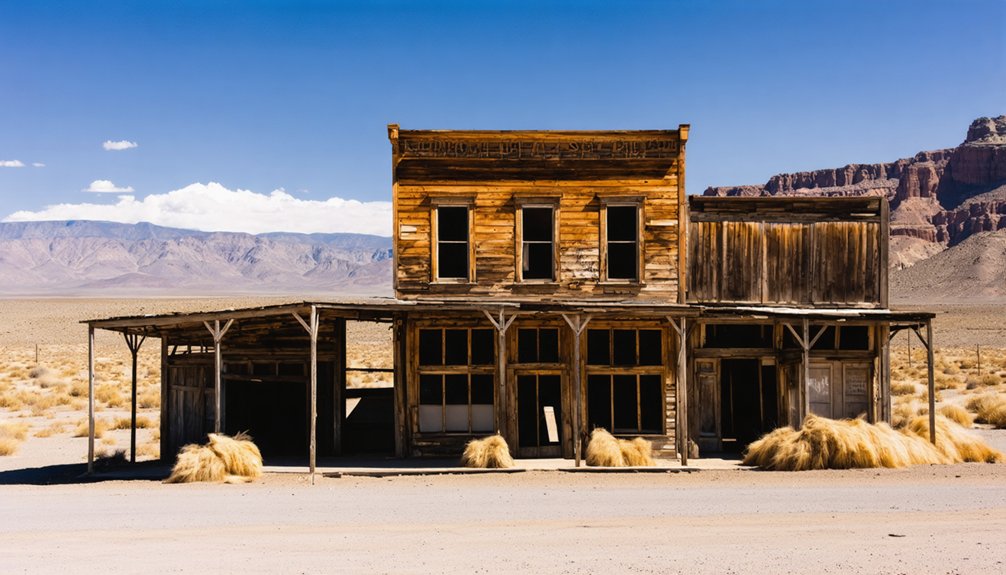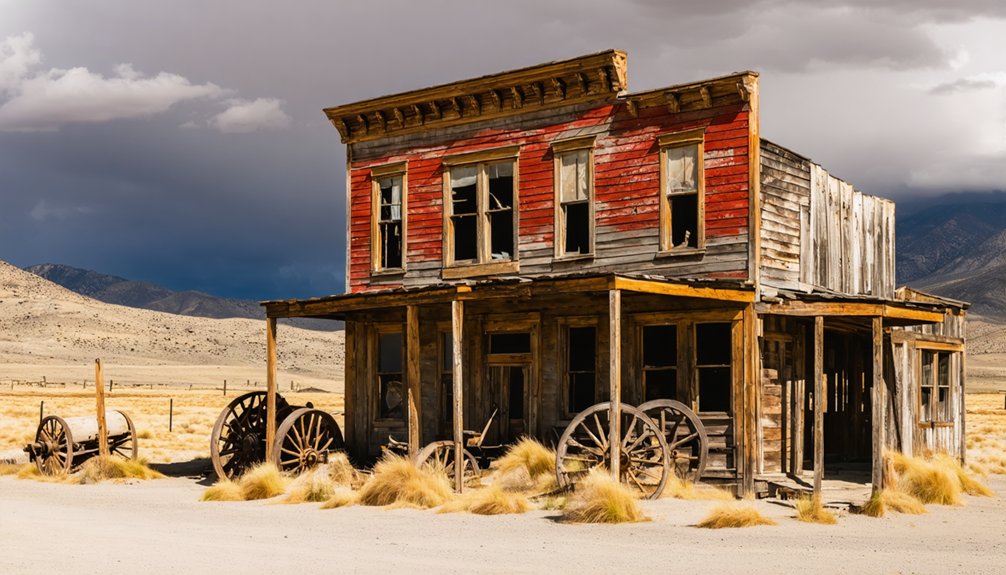America currently has approximately 4,530 documented ghost towns across all fifty states. You’ll find Texas leads with around 550 abandoned settlements, while Oklahoma, Kansas, and California each host over 240 ghost towns. These phantom landscapes emerged primarily from resource depletion, transportation shifts, environmental disasters, and economic competition. Western states show the densest clustering, though urban areas now face similar abandonment trends. The stories behind these vacant communities reveal America’s complex economic evolution.
Key Takeaways
- There are approximately 4,530 ghost towns across all fifty states in America.
- Texas leads with around 550 ghost towns, followed by California with 380 and Kansas with 308.
- Ghost towns exist on a spectrum from completely abandoned (zero inhabitants) to semi-ghost towns with minimal populations.
- About 211 American ghost towns are classified as “barren,” having minimal remains of their original settlements.
- Western states have the highest concentration of ghost towns, primarily resulting from abandoned mining settlements.
Defining America’s Ghost Towns: What Counts & What Doesn’t
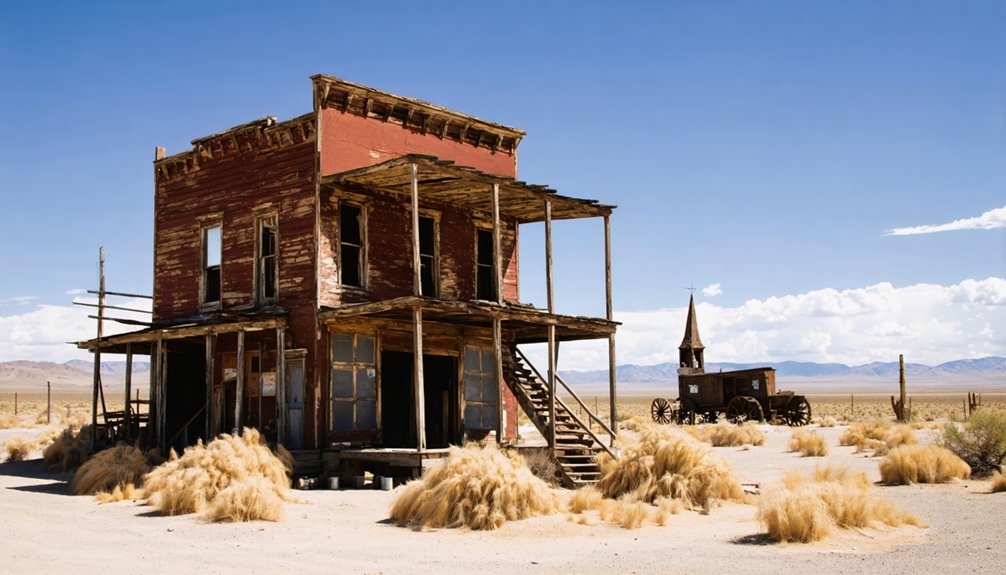
When defining America’s ghost towns, scholars must navigate a complex spectrum of abandonment rather than relying on absolute criteria. The defining criteria range from complete desertion to communities with skeleton populations where the original purpose has vanished.
Defining ghost towns requires understanding abandonment as a spectrum, not an absolute state.
Ghost town characteristics typically include tangible physical remains—from intact buildings to mere foundations—and the critical requirement that the town’s economic foundation has collapsed. Many sites are characterized by roofless buildings and structures that have been partially reclaimed by nature.
You’ll find that true ghost towns have zero inhabitants, while semi-ghost towns maintain minimal populations like Elkhorn, Montana. Public access is considered essential for a location to be officially classified as a ghost town.
Interestingly, some thriving tourist destinations like Tombstone, Arizona retain the ghost town label despite active populations, as they no longer serve their founding purpose.
This classification flexibility acknowledges the nuanced reality of American settlement patterns and economic shifts.
The Grand Total: Current Ghost Town Count Across the U.S
You’ll find America’s phantom landscape more extensive than commonly imagined, with approximately 4,530 ghost towns scattered across all fifty states.
The count varies considerably by region, with Texas leading at around 550 abandoned settlements, while states like Oklahoma, Kansas, and California each host over 240 ghost towns.
Ghost towns exist in various conditions, with 211 classified as barren sites where almost nothing remains of the original settlement.
These figures remain somewhat fluid, as definitions of what constitutes a ghost town continue to evolve—from completely abandoned historic mining settlements to partially vacant modern urban neighborhoods with high vacancy rates. Recent trends show more than half of small towns in America are losing residents, contributing to the growing phenomenon of urban decline.
America’s Phantom Landscape
Thousands of abandoned settlements dot the American landscape, creating a phantom geography that reveals the nation’s economic ebbs and flows throughout history. This haunted history persists in over 4,500 ghost towns nationwide, with Texas leading at 511 documented sites.
These cultural remnants tell a compelling story of American mobility and resource exploitation.
The national distribution reflects distinct regional patterns:
- Western states contain the highest concentration, dominated by mining settlements.
- Great Plains ghost towns largely resulted from agricultural failure during the Dust Bowl.
- Texas experienced unique abandonment waves following the 1901 Spindletop oil discovery.
- Modern “ghost town” ZIP codes continue to emerge with property values 14-80% below state averages.
You’re witnessing the physical manifestation of economic cycles that have repeatedly transformed American communities. Oklahoma ranks second with 236 ghost towns, most emerging from ambitious land runs that created settlements unable to sustain long-term economic viability. Recent data shows that areas like Flint, Michigan are evolving into modern ghost towns with 15.0% vacant homes reflecting severe economic decline.
Counting the Uncountable
Quantifying America’s ghost towns presents a remarkable methodological challenge, as the current estimate of over 4,500 abandoned settlements represents only documented cases within a constantly shifting landscape.
The geographic distribution reveals telling patterns: Texas leads with 511 ghost towns, followed by California (346) and Kansas (308), creating prime territories for urban exploration enthusiasts.
Western states dominate due to boom-bust mining cycles, while Great Plains states bear the scars of Dust Bowl abandonment. Montana contributes significantly with over 100 ghost towns scattered across its historical landscape.
Historical preservation efforts often focus on the most intact examples, with some being repurposed as tourism destinations. Websites like Ghosttowns.com serve as invaluable resources for researchers documenting these abandoned settlements.
Methodology varies between researchers, with counts derived from historical records, tax assessor data, and ZIP code analysis.
This statistical uncertainty paradoxically adds to these places’ mystique—some ghost towns exist in that liminal space between documented history and folklore.
Definitions Matter Most
Just how many ghost towns exist in America? The answer depends entirely on your definition. Research estimates range from 3,800 to 4,531 abandoned settlements nationwide, with significant variation based on how “abandonment” is classified.
When analyzing ghost towns by their abandonment reasons and tourism potential, four distinct categories emerge:
- Historical ruins with zero residents (complete abandonment)
- Semi-abandoned communities with minimal remaining population
- Modern “ghost towns” defined by high vacancy rates (≥19.6%)
- Restored ghost towns repurposed for heritage tourism
Texas and California lead in historical ghost towns, primarily from mining and oil booms, while Great Plains states feature numerous farming communities lost to the Dust Bowl. Many of these towns experienced rapid decline when mining resources depleted, forcing residents to seek opportunities elsewhere. Centrilia, Pennsylvania stands as a prime example of how underground fires can render towns completely uninhabitable for generations.
This geographic distribution reflects America’s complex economic history and the perpetual freedom to migrate where opportunity calls.
Top 5 States With The Highest Number of Abandoned Settlements
You’ll find Texas dominating America’s ghost town landscape with an impressive 511 abandoned settlements, nearly 50% more than second-place California’s 346 sites.
The western states, particularly California, Kansas, Oklahoma, and South Dakota, form the remainder of the top five, collectively accounting for over 1,600 documented ghost towns nationwide.
These abandoned settlements primarily emerged from short-lived economic booms in mining, oil production, and agriculture—industries whose decline left behind the haunting architectural remnants that now attract heritage tourists and history enthusiasts.
Texas Leads Nationwide
When examining the nationwide distribution of ghost towns, a striking geographical disparity emerges with Texas decisively leading the count. The Lone Star State contains 511 abandoned settlements—significantly outpacing California’s 346 and Kansas’s 308.
These Texas ghost towns spread across all 254 counties, revealing patterns of historical development and subsequent decline.
The historical significance of these abandoned communities manifests through:
- Wilson County’s concentration of 31 ghost towns, creating a regional epicenter of abandonment
- Twenty-five ghost towns clustered within 25 miles of New Braunfels
- An average of nearly four ghost towns per county throughout Texas
- Predominant founding periods during the 19th and 20th centuries
This distribution illuminates how freedom-seeking settlers established communities that later couldn’t sustain themselves as economic conditions evolved throughout the frontier state.
Western Mining Legacy
While Texas demonstrates an extraordinary concentration of abandoned settlements, the American West’s mining heritage represents the quintessential ghost town narrative that captures public imagination.
Colorado harbors over 200 ghost towns, with Saint Elmo standing among America’s best-preserved.
California’s Bodie exemplifies mining heritage tourism with 100+ structures maintained in “arrested decay.”
Nevada’s boom-and-bust cycles created dramatic histories in Goldfield and Belmont, where Dirty Dick’s Saloon continues operating off-grid since 1867.
Arizona’s Castle Dome evolved from a World War bullet-manufacturing center to a museum preserving mining artifacts.
Montana’s Garnet, once home to 13 saloons serving 1,000 residents, now welcomes visitors during annual Garnet Day celebrations.
These five states showcase how extraction economies created vibrant communities that, when minerals depleted, transformed into cultural treasures now preserved through ghost town tourism.
Why Towns Become Ghosts: Primary Causes of Abandonment
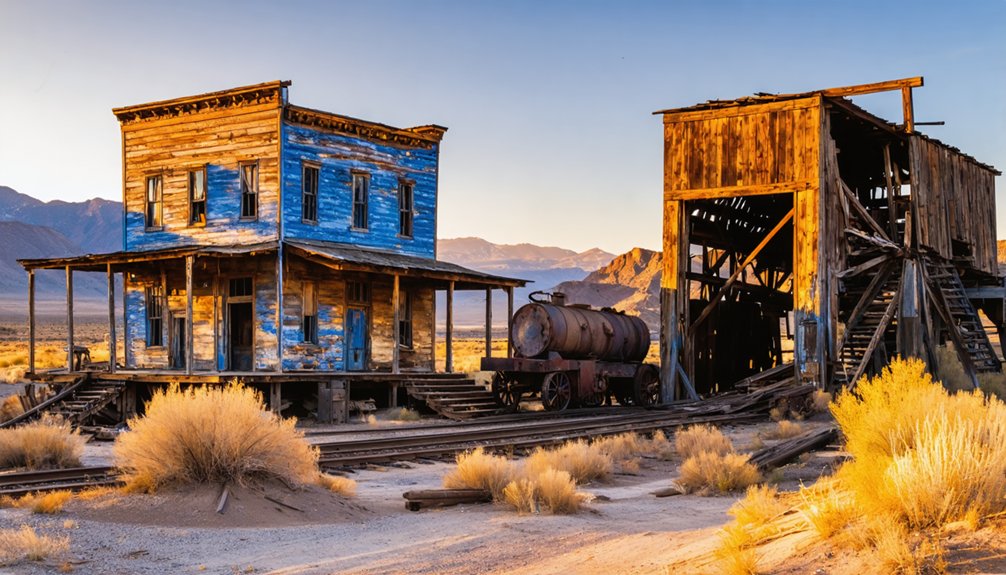
Throughout America’s history, towns have transformed into abandoned shells through distinct and identifiable patterns of economic and environmental collapse.
These settlement failures represent significant chapters in our cultural heritage, revealing the fragility of human enterprise against market forces and natural systems.
The empty storefronts and crumbling foundations of failed towns stand as monuments to our economic vulnerability and environmental impermanence.
Four primary mechanisms of town abandonment include:
- Resource depletion when mines, timber, or other extractive industries exhaust available materials
- Transportation infrastructure shifts that reroute economic activity away from established communities
- Environmental catastrophes rendering locations uninhabitable through fires, sinkholes, or pollution
- Economic competition from neighboring settlements with superior resources or positioning
You’ll find these abandonment patterns repeating across America’s landscape, each ghost town offering historical significance as physical evidence of capitalism’s creative destruction and nature’s persistent reclamation of human spaces.
Regional Patterns: Where Ghost Towns Cluster and Why
America’s ghost towns cluster in distinct regional patterns that reveal the economic and environmental vulnerabilities unique to each area of the country.
The West shows dense regional clustering with Texas leading at 550 ghost towns, followed by California (380) and New Mexico (400), primarily due to mining and oil boom-bust cycles.
Great Plains abandonment factors center around agricultural collapse, with Kansas’s 308 ghost towns largely resulting from the Dust Bowl.
The Northeast contains considerably fewer ghost towns—Rhode Island has just one—as abandoned settlements were typically absorbed into expanding urban areas.
Southern states exhibit more varied abandonment factors with Texas counties showing the highest concentration.
Place name patterns reveal regional similarities, with “Center Point” appearing exclusively in Texas while “Hopewell” spans multiple southern states, reflecting the different historical trajectories of regional development.
Modern Ghost Communities: The New Wave of Abandonment

The concept of ghost towns has evolved dramatically in the 21st century, with a concerning new trend of population decline emerging within previously vibrant metropolitan areas. This phenomenon represents urban decay at an alarming scale, with once-thriving cities experiencing sustained economic decline.
Today’s ghost towns aren’t abandoned mining camps—they’re our major cities slowly emptying as opportunity fades and decay sets in.
Data reveals four critical indicators of these modern ghost communities:
- Major population losses (San Francisco -7.4%, St. Louis -6.6%)
- Elevated vacancy rates (Montgomery, AL with 19.6% vacant homes)
- Plummeting construction (Akron’s 69% drop in building permits)
- Widening housing value disparities (some areas at just 14% of state medians)
You’ll find this isn’t limited to rural settings; metropolitan centers from New York to New Orleans are hemorrhaging residents as affordability crises and stagnant economic opportunities drive migration patterns that reshape America’s urban landscape.
America’s Most Fascinating Abandoned Towns and Their Stories
When examining America’s most fascinating ghost towns, one encounters compelling narratives of boom-and-bust cycles that have shaped the nation’s development.
Fort Jefferson in Florida stands as America’s largest brick structure, abandoned in 1906 after hurricane damage ended its 60-year history as a military outpost and Civil War prison—a haunting legacy of our coastal defenses.
In the West, mining communities tell forgotten histories of resource exploitation and subsequent collapse.
Harrisburg, Utah exemplifies this pattern, established in 1862 but abandoned by 1895 due to devastating drought.
Meanwhile, Texas’s 511 ghost towns—the nation’s highest concentration—primarily emerged from oil industry fluctuations following the 1901 Spindletop discovery, demonstrating how rapidly prosperity can vanish when economic foundations erode.
Vacancy Rates and Economic Impact of Ghost Towns Today
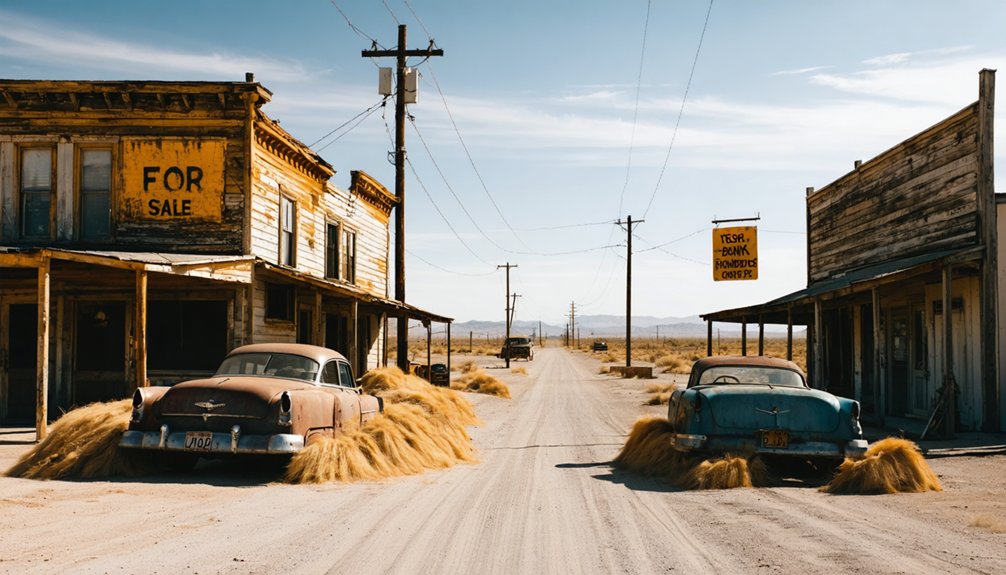
Contemporary vacancy data reveals a complex national landscape far removed from the historical ghost towns of America’s past. National residential vacancy rates hover around 1.32%, masking significant regional disparities that signal potential economic consequences in specific communities.
The data exposes concerning vacancy trends:
- Long-term abandoned properties reach alarming levels in cities like Dayton (46.2%) and Jackson (44.8%).
- Tourism-dependent regions face vacation rental occupancy declines of 21% year-over-year.
- Commercial vacancy rates in major cities like San Francisco (29.3%) reflect shifting economic realities.
- Population decline correlates directly with reduced building permits and increased long-term vacancies.
You’re witnessing modern “ghost town” dynamics through these statistics—not the abandoned mining towns of yesteryear but emerging economic dead zones where property abandonment signals deeper structural challenges requiring innovative policy interventions.
Frequently Asked Questions
Can Ghost Towns Be Legally Reclaimed by Private Citizens?
Like unearthing buried treasure, you can reclaim ghost towns, though property rights complications create substantial legal challenges. Acquisition requires steering through ownership determinations, adverse possession laws, and preservation regulations meticulously.
How Do Seasonal Tourist Ghost Towns Differ From Truly Abandoned Ones?
You’ll find seasonal tourist ghost towns revive with cyclical tourism activities, while maintaining infrastructure. Truly abandoned ones exhibit permanent desertion, often preserving historical significance without economic functionality or organized human presence.
Are There Any Ghost Towns Underwater Due to Dam Projects?
Like silent sentinels beneath rippling waters, numerous American towns rest in watery tombs. You’ll find dozens of communities submerged by dam projects, their underwater archaeology revealing submerged history when reservoir levels occasionally drop during droughts.
What Happened to the Inhabitants of America’s Largest Ghost Towns?
You’ll find inhabitants migrated when economic resources depleted, natural disasters struck, or industry declined. Many sought opportunities elsewhere, leaving only remnants of historical significance in these once-thriving communities.
Do Any Ghost Towns Have Active Preservation or Restoration Efforts?
As ruins stand silently against time’s passage, you’ll find numerous ghost town preservation efforts nationwide. Government agencies, nonprofits, and private investors fund restoration projects, preserving these cultural touchstones for your exploration and historical understanding.
References
- https://www.loveexploring.com/gallerylist/188219/the-us-state-with-the-most-ghost-towns-revealed
- https://247wallst.com/housing/2024/04/11/americas-modern-ghost-towns-2/
- https://xlcountry.com/montana-ghosts-towns/
- https://en.wikipedia.org/wiki/Lists_of_ghost_towns_in_the_United_States
- https://www.geotab.com/ghost-towns/
- https://www.youtube.com/watch?v=u1KkAEZYqZY
- https://joybird.com/blog/top-ghost-towns-in-america/
- https://www.legendsofamerica.com/gt-ghosttownethics/
- https://freepages.history.rootsweb.com/~gtusa/definitions.pdf
- https://westernmininghistory.com/664/what-is-a-ghost-town-wmh-town-classifications-explained/
